Happy Birthday, Judy Canova!
There’s a reason why Judy Canova was frequently referred to as “The Ozark Nightingale” and “The Jenny Lind of the Ozarks.” Judy was blessed with an incredible singing voice, and at one point in her professional career she had serious aspirations to become an opera singer. Fate had other plans for Ms. Canova, however. The woman born Juliette (also Julietta) Canova on this date in Starke, Florida in 1913 (though her obituary in The New York Times noted 1916) became typecast early in vaudeville as a “hillbilly” performer. She would dutifully make that her bread-and-butter persona in movies and on radio throughout her lengthy tenure in show business.
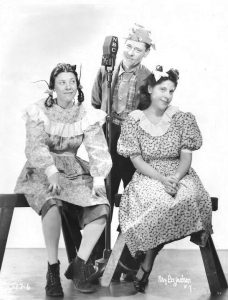 Born to Joseph Francis and Henrietta E. Canova, Judy was one of seven Canova kids—and with two siblings, Annie and Zeke, she would form a musical aggregation known as the Three Georgia Crackers. They started out playing in various Florida nightclubs before hitting the big time at Manhattan’s The Village Barn. The Three Canovas (with brother Peter) would make their Broadway debut in Calling All Stars in 1934 and later grace the cast of Yokel Boy (1939)…while on her own, Judy was featured in the Ziegfeld Follies of 1936. The trio (and Peter) also established a beachhead in motion pictures like In Caliente and Broadway Gondolier (both 1935).
Born to Joseph Francis and Henrietta E. Canova, Judy was one of seven Canova kids—and with two siblings, Annie and Zeke, she would form a musical aggregation known as the Three Georgia Crackers. They started out playing in various Florida nightclubs before hitting the big time at Manhattan’s The Village Barn. The Three Canovas (with brother Peter) would make their Broadway debut in Calling All Stars in 1934 and later grace the cast of Yokel Boy (1939)…while on her own, Judy was featured in the Ziegfeld Follies of 1936. The trio (and Peter) also established a beachhead in motion pictures like In Caliente and Broadway Gondolier (both 1935).
Judy Canova was still a teenager when Rudy Vallee invited her and her siblings to appear on his popular radio program The Fleischmann Hour in 1933. The Canovas would guest frequently on that and subsequent Vallee series, and later became regulars on Paul Whiteman’s Musical Varieties in 1936 (a show that was handed off to Shep Fields and became The Rippling Rhythm Revue in early 1937). Judy, Annie, and Zeke also made appearances on The Chase & Sanborn Hour in the fall of 1938, joining the all-star cast of Nelson Eddy, Dorothy Lamour, Don Ameche, and Edgar Bergen (and Charlie McCarthy).
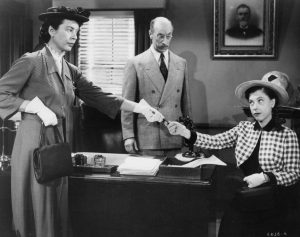 Judy Canova would make two more motion pictures with her siblings Annie and Zeke (1937’s Artists and Models and Thrill of a Lifetime) before deciding to become a solo act. (She had given that a try with a film she made at Warner Bros., Going Highbrow [1935].) Judy would make the majority of her solo starring films at Republic Pictures—beginning with 1940’s Scatterbrain—where the specialty was serials and B-Westerns. Canova would be one of Republic’s biggest box office assets, and her economically produced musical comedies would prove quite popular with movie audiences until her last film at the studio, Lay That Rifle Down (1955).
Judy Canova would make two more motion pictures with her siblings Annie and Zeke (1937’s Artists and Models and Thrill of a Lifetime) before deciding to become a solo act. (She had given that a try with a film she made at Warner Bros., Going Highbrow [1935].) Judy would make the majority of her solo starring films at Republic Pictures—beginning with 1940’s Scatterbrain—where the specialty was serials and B-Westerns. Canova would be one of Republic’s biggest box office assets, and her economically produced musical comedies would prove quite popular with movie audiences until her last film at the studio, Lay That Rifle Down (1955).
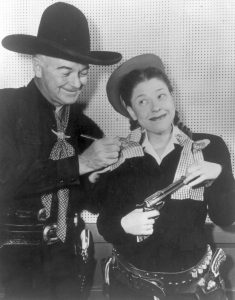 On radio, Judy Canova made guest appearances on the likes of Command Performance and The Kraft Music Hall while yukking it up with Fred Allen, Eddie Cantor, and George Burns & Gracie Allen. July 6, 1943 would mark the debut of her own self-titled sitcom over CBS, The Judy Canova Show (though it originally went by Rancho Canova). A fresh-faced innocent from the mythical hamlet of “Cactus Junction,” Judy had moved to Southern California where she lived with her Aunt Aggie (played at times by Verna Felton and Ruth Parrott) and maid Geranium (Ruby Dandridge). Canova would sing both novelty and serious numbers on the show, whose content (to borrow a quote from Fred Allen) “frequently mulched the maize to monumental heights.” Here’s an example:
On radio, Judy Canova made guest appearances on the likes of Command Performance and The Kraft Music Hall while yukking it up with Fred Allen, Eddie Cantor, and George Burns & Gracie Allen. July 6, 1943 would mark the debut of her own self-titled sitcom over CBS, The Judy Canova Show (though it originally went by Rancho Canova). A fresh-faced innocent from the mythical hamlet of “Cactus Junction,” Judy had moved to Southern California where she lived with her Aunt Aggie (played at times by Verna Felton and Ruth Parrott) and maid Geranium (Ruby Dandridge). Canova would sing both novelty and serious numbers on the show, whose content (to borrow a quote from Fred Allen) “frequently mulched the maize to monumental heights.” Here’s an example:
STRAIGHT MAN: One of my ancestors was a Knight of the Royal Order of the Bath—or don’t you know the Royal Order of the Bath?
JUDY: Why, shore—on Saturday night, it was Paw first and then all the kids in order of their ages!
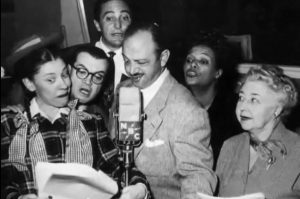 The Judy Canova Show distinguished itself by showcasing an impressive cast of old-time radio veterans: Hans Conried (as the constantly complaining boarder Mr. Hemingway), Sheldon Leonard (as Judy’s cabbie boyfriend Joe Crunchmiller), Gerald Mohr (as the buff Humphrey Cooper, Judy’s one-time fiancé), and Joseph Kearns (as the eccentric Bentley Botsford). Gale Gordon, Elvia Allman, George Neise, and Sharon Douglas also appeared on occasion, and Jim Backus transplanted his “Hubert Updike III” character from The Alan Young Show when that program closed up shop. The best-known cast member of the Canova show was unquestionably Mel Blanc (as if he didn’t have enough on his plate already), who tackled quite a few characters—Pedro, Judy’s gardener, was the most frequent to appear. (“Pardon me for talking in your face, Senorita…thirty days hacienda, April, June, and sombrero.”) Judy’s program was heard over CBS until June 27, 1944; it then moved to NBC in January of 1945 and ran until May 28, 1953.
The Judy Canova Show distinguished itself by showcasing an impressive cast of old-time radio veterans: Hans Conried (as the constantly complaining boarder Mr. Hemingway), Sheldon Leonard (as Judy’s cabbie boyfriend Joe Crunchmiller), Gerald Mohr (as the buff Humphrey Cooper, Judy’s one-time fiancé), and Joseph Kearns (as the eccentric Bentley Botsford). Gale Gordon, Elvia Allman, George Neise, and Sharon Douglas also appeared on occasion, and Jim Backus transplanted his “Hubert Updike III” character from The Alan Young Show when that program closed up shop. The best-known cast member of the Canova show was unquestionably Mel Blanc (as if he didn’t have enough on his plate already), who tackled quite a few characters—Pedro, Judy’s gardener, was the most frequent to appear. (“Pardon me for talking in your face, Senorita…thirty days hacienda, April, June, and sombrero.”) Judy’s program was heard over CBS until June 27, 1944; it then moved to NBC in January of 1945 and ran until May 28, 1953.
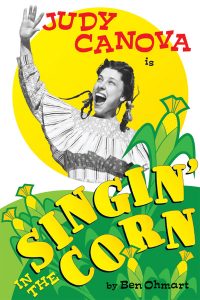 In addition to her successful radio show, Judy Canova made the guest star rounds on programs like The Abbott & Costello Show, The Harold Lloyd Comedy Theatre, The Lady Esther Screen Guild Theatre (a radio version of her 1942 film Joan of Ozark), Mail Call, The Radio Hall of Fame, Request Performance, The Sealtest Variety Theatre, and The Victor Borge Show. With the decline of the aural medium, Judy began following her radio brethren and sistren to the small screen. She would be a guest on venues like The Milton Berle Show and The Colgate Comedy Hour, and later stretch her acting range on series such as Alfred Hitchcock Presents and Police Woman. Canova’s last TV appearance before her death in 1983 was on an episode of The Love Boat.
In addition to her successful radio show, Judy Canova made the guest star rounds on programs like The Abbott & Costello Show, The Harold Lloyd Comedy Theatre, The Lady Esther Screen Guild Theatre (a radio version of her 1942 film Joan of Ozark), Mail Call, The Radio Hall of Fame, Request Performance, The Sealtest Variety Theatre, and The Victor Borge Show. With the decline of the aural medium, Judy began following her radio brethren and sistren to the small screen. She would be a guest on venues like The Milton Berle Show and The Colgate Comedy Hour, and later stretch her acting range on series such as Alfred Hitchcock Presents and Police Woman. Canova’s last TV appearance before her death in 1983 was on an episode of The Love Boat.
I’ve only scratched the surface on Judy Canova’s phenomenal show business career here—if you’re curious to check out more, may we recommend a purchase of Singin’ in the Corn, a one-of-a-kind biography on our birthday girl written by Ben Ohmart. It’s packed with family interviews and rare, unpublished photographs. Tarnation!

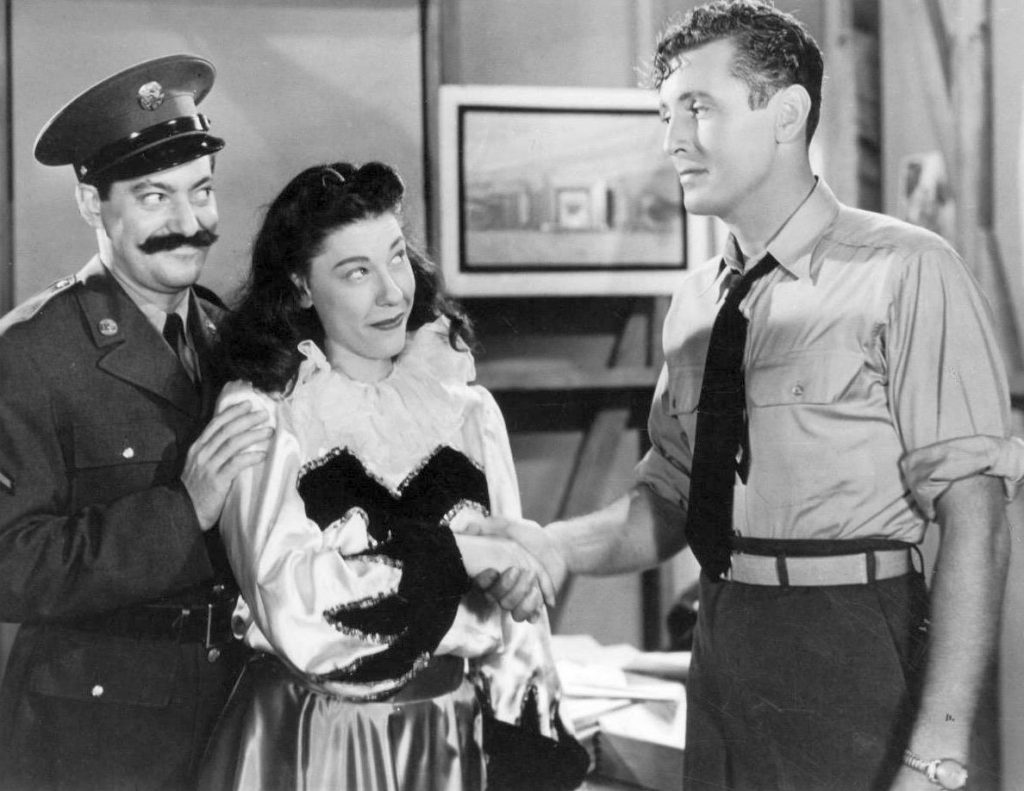

Sadly, the only thing this lady is now known for is being the mother mother of Diana Canova, the actress who was a cast member of Soap(1977-81) on ABC.